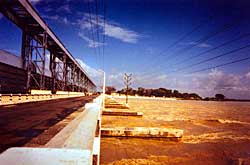 Foreign aid to Nepal used to be confined to infrastructure projects, and Nepal's rulers played off regional rivals India and China or superpowers the US and USSR to extract assistance for highways, dams and even cigarette factories. Later, aid was channelled more towards poverty alleviation and projects designed to lift living standards.
Foreign aid to Nepal used to be confined to infrastructure projects, and Nepal's rulers played off regional rivals India and China or superpowers the US and USSR to extract assistance for highways, dams and even cigarette factories. Later, aid was channelled more towards poverty alleviation and projects designed to lift living standards. But Indian aid for large infrastructure projects diminished as European, Japanese and American donors dominated foreign aid to Nepal. By the late 80s and into the 90s, India hardly figured at all on the list of donor countries. But recently there has been a sharp upswing in Indian grants and aid projects to Nepal. With the Maoist insurgency and the danger of its spillover into India, Nepal's development has become a strategic issue for India.
India is still investing in big projects: there are polytechnic institutes being set up in Hetauda and Morang, a project to upgrade feeder roads in the tarai, four border checkpoints at Birgunj, Bhairawa, Biratnagar and Nepalganj are being upgraded, the BP Koirala Institute of Health and Science in Dharan and Bir Hospital Trauma Centre are being expanded and a fibre-optic backbone along the tarai is nearing completion.
India is already Nepal's biggest donor of military hardware to the Royal Nepali Army, with six helicopters, mine-protected vehicles, assault rifles and large quantities of ammunition. Even with joint venture investments in telecom, transportation or hydropower, there are indications that New Delhi favours Indian public sector corporations to be involved rather than private Indian companies.
New Delhi put economic cooperation with Nepal on a formalised footing with the establishment of the India Cooperation Mission, and also drifted away from large projects. It has increased its development cooperation assistance to Nepal in recent years to Rs 1.6 billion per year.
"In the mid-90s, efforts began to streamline this cooperation and focus not only on big landmark projects, but also ones that ensure that economic cooperation directly reaches the people of Nepal at a grassroots level through community development projects," one embassy official told us.
In the past, India helped in building hydropower plants like Trisuli, the Tribhuban Highway and sections of the Mahendra Highway, most of the airports along the tarai and major hospitals. Now, the focus seems to be more on helping district and village level schools and even hospitals by gifting ambulances.
All aid comes with strings attached, it's just that some countries are better at hiding it. "Indian aid comes under India's strategy to maximise benefits from Nepal's natural resources," says foreign aid expert Keshav Acharya. "This has been seen in the past and it is still valid." Past projects to build barrages along the border on the Kosi and Gandaki have become symbols of this attitude in Nepali public perception, and this is why there are misgivings about letting India get involved in Upper Karnali, Budi Gandaki or the Kosi High Dam proposals.
Embassy officials confirm that India is interested in taking up several major hydroelectric projects. Money has also been set aside for maintenance of embankments and other schemes like the Sapta Kosi-Sun Kosi Multipurpose Project. There are even bilateral efforts underway to revive political hot potatoes like the Pancheswor irrigation and power project, which is still stuck a decade after the signing of the Mahakali Treaty.
Aid pundits say initial Indian aid, like any other aid, used to be project-tied, but that today it is policy-tied. "The aid we receive from India reflects its foreign policy doctrine towards Nepal," says Gunanidhi Sharma, a professor at Tribhuban University. "These policies follow various treaties Nepal has signed with India over the years."
Indian officials, however, say their aid is driven by the need to look at mutual benefit and cooperation. "The emphasis has always been on core sectors such as education, health and development of infrastructure because we believe that cooperation in these fields will contribute to economic and social stability which will be mutually beneficial," said an official.
Even so, as a neighbour that shares an open border with Nepal, India has often looked at Nepal through a strategic geopolitical lens. In his book Foreign Aid and Politics in Nepal, first published in 1965, Eugene Bramer Mihaly wrote: 'India planned to build more roads from the Indian plains into Nepal, to construct all-weather airfields in the vital Nepal plains (the only part of Nepal which could serve as a staging area for a force intending to attack India), and to carry out projects which could win support among the inhabitants of the plains.'
In that sense, experts say India's aid strategy towards Nepal hasn't changed. Much of Indian assistance still goes to the tarai, offsetting some of the neglect that Kathmandu has shown in the past to the region. One foreign aid expert told us: "It is a sort of buffer zone protection, they want the areas in their immediate vicinity to be developed."
If it was geopolitics that drove aid in the past, the Maoist insurgency in Nepal and its links to Naxalites across the border mean that for New Delhi peace, stability and development in Nepal have become strategic points. For this, experts note, a developed and prosperous Nepal should be as much in India's interest as Nepal's own.


